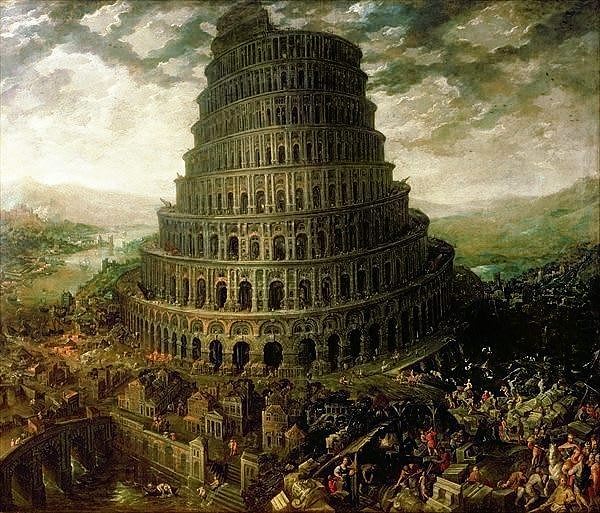What does Hashem have against skyscrapers?
Perched amongst the many enigmatic post Creation stories, the Tower of Bavel narrative reminds us that superficial familiarity with these episodes just won’t do; here, a simple read of the text only serves to pique our curiosity and deepen the story’s mysterious nature:
11:1 All on earth had the same language and the same words. 2 And as they migrated from the east, they came upon a valley in the land of Shinar and settled there. 3 They said to one another, “Come, let us make bricks and burn them hard… 4 And they said, “Come, let us build us a city, and a tower with its top in the sky, to make a name for ourselves; else we shall be scattered all over the world.” 5 The LORD came down to look at the city and tower that man had built, 6 and the LORD said, “If, as one people with one language for all, this is how they have begun to act, then nothing that they may propose to do will be out of their reach. 7 Let us, then, go down and confound their speech there, so that they shall not understand one another’s speech.” 8 Thus the LORD scattered them from there over the face of the whole earth; and they stopped building the city. 9 That is why it was called Babel, because there the LORD confounded the speech of the whole earth; and from there the LORD scattered them over the face of the whole earth.
Much ambiguity swirls around our story’s protagonists, the Dor Haflaga. What were the devarim achadim, the “same words” that encapsulated the whole land? Why is their locale, the valley of Shinar, of any significance? Of what relevance is their brick making occupation? Where does language figure into the whole episode?
More than the details, it is hard to grasp the people’s raison d’etre and its sinful nature. Is this nothing more than a macro grasp for unity – a classic and desirable (if somewhat Jewishly unattainable) virtue? Unsurprisingly, since we do not grasp the severity of the problem, we are mystified at the harsh Divine response and fail to see the midah kineged midah (quid pro quo) nature of the punishment?
The Talmud opens a window for us to comprehend the gravity of the communal agenda.
R. Jeremiah b. Eleazar said: They split up into three parties. One said, ‘Let us ascend and dwell there;’ the second, ‘Let us ascend and serve idols;’ and the third said, ‘Let us ascend and wage war [with God].’ … It has been taught. R. Nathan said: They were all bent on idolatry.
And yet the simple unvarnished reading of the text provides no hint to the Talmudic understanding of idolatry – leaving us to ponder the chasm between Talmud and text!
Our great meforshim get to work. What is the primary fear of that society? “lest we shall be scattered all over the world” Ohr HaChayim and others make a simple but remarkable claim. In brief their thrust is:
The generation desired a centralized, unified and uniform society – one where the human comfort zone would trump human exploration and inquiry. A central marker to all, the Tower was to be a great landmark for none to lose their bearing.
So what’s wrong with being comfortable?
Towards the end of his life, Rav Shimshon Raphael Hirsch announced he was headed on a tour of Switzerland. Responding to his alarmed and curious students’ concerns, he remarked: “When I come before the Almighty, I will have an answer for many things. But what will I tell Him when He asks me, ‘Shimshon, did you see my Alps?’
Hashem created a beautiful world – for us. To ignore it is to ignore Him. Conversely, to appreciate the complexity and beauty of His universe, says Rambam, is to love God. Ein Tzayar K’elokeinu – there is no artist like our God, states the Talmud and Zohar.
Appreciation alone is not the point. Our human imperative is to reveal God’s hiddenness within the concealed world. Lasheves yetzarah, He created us to inhabit the world – to grow it, conquer it and channel it – in His service. Till this very day, human conquest empowers and humbles. Even as the Human Genome project opened new vistas for the geneticist, it left the honest scientist breathless to consider with newfound appreciation the complexity that is man.
While the danger of empowerment is real and can not be understated, the Torah also understood that an ostrich in the sand mentality does not foster Divine appreciation. Similarly, a generation, such as Dor Haflaga that seeks to form a monolithic and self indulgent society bodes ill for the spirit of creative thought and action critical to appreciating Hashem within our world.
Netziv adds an element of insidiousness into the mixture. The tower represents a premeditated quashing of free thought. Man’s attempt to control society from a watch tower was a veiled effort to create a totalitarian society.
Perhaps this is the deeper meaning of the Talmudic identification of Bavel with idolatry. A unified, narcissistic society preoccupied with its name at the expense of His Name, materialism over real meaning, completely misses the point of life and is a de facto rebellion against the world that God willed for His people.
As I sit a few hundred meters away from Beverly Hills, the land of fine restaurants and finer cars, I wonder if this message is still relevant today.
Good Shabbos, Asher Brander
Rabbi Asher Brander is the Rabbi of the Westwood Kehilla, Founder/Dean of LINK (Los Angeles Intercommunity Kollel) and is a Rebbe at Yeshiva University High Schools of Los Angeles
The words of this author reflect his/her own opinions and do not necessarily represent the official position of the Orthodox Union.
